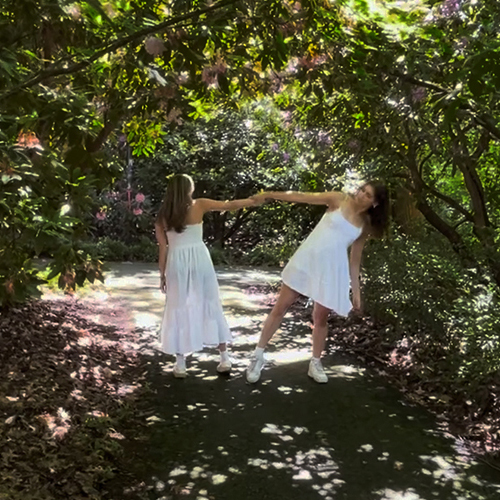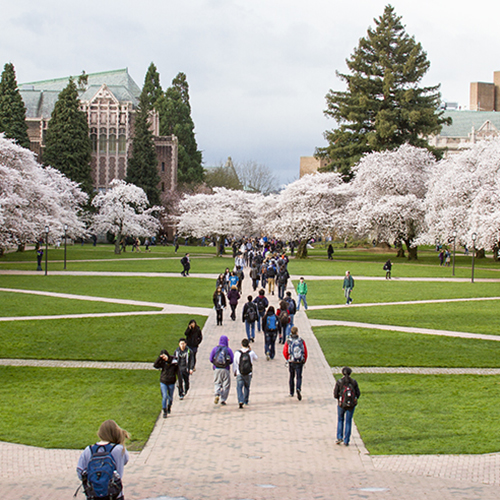People are walking all over artworks created by Layne Goldsmith’s students, and the students couldn’t be more pleased.
The artworks are handwoven rugs, created for local clients as part of a new School of Art course, Commissions: The Artist-Client Process. The course, designed and administered by Goldsmith, gave students the opportunity to work with clients to create one-of-a-kind artworks.
“So often in studio art courses we go into theory and practice but not application—how to use your artwork as a way to earn a living,” says Goldsmith, professor of fibers. “I wanted students to understand what goes into the process of commission work, and I felt that would work best in a practicum setting. It’s not something you can learn by talking about it. You have to do it.”
One problem: to provide students an authentic commission experience, Goldsmith needed to recruit clients. And not just any clients, but individuals willing to work with students who are new to the commission process.

“Commissions usually grow out of a client’s attraction to a specific artist’s work,” says Goldsmith. “In this case, we were asking people to take a gamble on sponsoring a student whose work was unknown to them.”
Goldsmith spent months identifying and meeting with potential sponsors. “For every three or four presentations I made, we probably got one person interested,” she says. In the end, she secured 15 sponsors who agreed to serve as mentors to the students, be involved in the educational process, and contibute $2,500 each to cover the costs of design, weaving, and project administration.
“It was a very sophisticated group of clients,” adds Goldsmith, “that included architects, graphic designers, industrial designers, interior designers, textile designers, collectors, and gallery professionals, among others.”
With the sponsors on board, Goldsmith screened the 15 art students for the course, based on sketchbooks and working design notebooks they were asked to submit. “I didn’t want to see their finished work,” says Goldsmith. “I wanted to see evidence of their thinking and problem solving skills.”
Communicating with Clients
Before the first class session, Goldsmith paired the students with clients and had them set up individual design meetings. Some clients had specific ideas about what they wanted; others gave students free rein.
“The clients who had specific ideas got the process started more quickly,” says Rachel Meginnes, a graduate student in the Fibers Program. Meginnes met with her client just a handful of times during the quarter; other student-sponsor teams met as often as twice a week.
Interior designer Sharon Campbell remembers the first few meetings with her student as “awkward” because the commission process was new for the student. “It took a few sessions for her to become comfortable with me, and to really understand my aesthetic,” Campbell recalls. But by the end of the process, the two were in sync. “The student I worked with was a delight. I appreciated her interest, her approach, and her core character,” says Campbell. “I plan to keep in touch with her to follow what I think will be a very successful career.”

By mid-quarter, all of the clients had signed off on the designs for their rugs. Each team then gave a presentation in class, discussing their process from preliminary design sketches through final design. “The clients were able to share their own particular points of view with the whole class,” says Goldsmith, “so students were able to learn from all of them.”
Shelby Richardson, an interdisciplinary visual arts major, found the presentations invaluable. “Most people would have to experience a range of clients over years to see all the variations that we were able to see through those presentations,” she says. Adds Meginnes, “To see how the clients and students were interacting and to hear about the obstacles they had to overcome was really interesting.”
In fact, Meginnes considers her own client-student presentation a high point of the course for her. “I didn’t expect that to be the case,” she admits. “But it meant a lot to me—and to my client—to define to the class what the process had involved. I learned a lot from him.”
The students also heard presentations from guest speakers, including artists with years of experience working with clients, an artist who had carpets woven in Nepal, a lawyer from Washington Volunteer Lawyers for the Arts who discussed copyright and contract issues, a representative of the fair trade group Ten Thousand Villages, and others.
Next Step: Nepal
With the rug designs finalized, the next step was to send the designs to weavers in Nepal, who would create the rugs from the students’ detailed drawings and ship them to Seattle in early summer.
Goldsmith chose to have the rugs woven in Nepal to ensure they would be of consistent high quality. She had visited Nepal in Spring 2003, traveling through its rug manufacturing region to confirm the environmental, fair trade, and labor practices of the weaving companies the class would be using.

For Meginnes, this awareness of fair trade practices was important. “I would have been uncomfortable sending my designs off to another part of the world without knowing how people are being compensated and what the conditions are,” she says. “That was important to me to find out.”
So important, in fact, that after the quarter ended she and two other students joined Goldsmith on another research trip to Nepal. “We visited companies from 8 am to 6 pm every day,” Meginnes says. “It was a chance to see different weavers’ conditions and test out what they were capable of doing. It made me feel good about being part of this process, about sending my work off to the weavers there.” As a result of the trip, Meginnes and several classmates have been hired to run the Seattle business office of a Nepalese weaving company.
Richardson also has found related work: she has a commission to design two rugs for an acquaintance’s home. Thanks to the course, she feels prepared.
“This course was the real thing,” she says. “When you know someone is going to have your rug in their home, it’s a totally different experience than working on other class projects. A lot of schools say they’re preparing you for the real world, but this really did.”
More Stories

Democracy by the Numbers
Mathematics and Democracy, an undergraduate mathematics course, explores the role of math in many aspects of democracy, from elections to proportional representation.

Dancing Across Campus
For the dance course "Activating Space," students danced in public spaces across the University of Washington's Seattle campus this spring.

Four Students Shine as 2024 Dean's Medalists
Meet the four new graduates honored as College of Arts & Sciences Dean's Medalists for 2024.